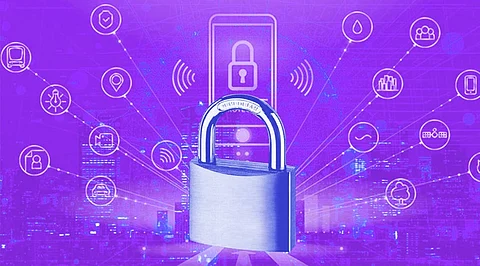
- Insights
- Cryptocurrencies
- Stocks
- White Papers
- Industry
- Geography
- Insights
- Cryptocurrencies
- Stocks
- White Papers
- Industry
- Geography


IoT is nothing but devices connected over the internet, where they can share data. That comes with advantages and disadvantages too. These IoT-connected devices have made one's life better and easy but on the other hand, security professionals are considering it as unnecessary and risky due to privacy and data security issues that are generated by these smart connected devices.
IoT is fascinating, which is why consumers are flocking to embrace it even before it is ready and before the devices themselves are completely compatible with security and safety standards. These IoT devices generate a lot of data with the help of their sensors and processors and then it is shared by the IoT gateways or other connected devices. A huge amount of data is generated by these devices and gives a rise to data privacy and security issues.
Currently, there are 30 billion smart devices in the market globally, and the forecast by Statista says it will cross 75 billion by 2025 and the global spending will touch around 1.1 trillion US dollars. And by 2025 the volume of data will be generated by these smart devices will be around 79.4 zettabytes.
Companies started embracing the IoT and predicting what else the technology will add to the areas and how it will get adopted but missing out on the main and the delicate part of IoT cybersecurity threats.
IoT is becoming more and more integrated into our everyday lives. However, it also comes with a great risk of security and it is increasing tremendously. IoT cyber-attackers are developing new ways to counter the security parameters of organizations. These cyber-attackers access sensitive information from the individual and organizations creating chaos. These attacks are going to get worse in the future and are unpredictable from where you are getting attacked.
Cybersecurity needs to take quick actions to defeat such events, antivirus, software, IPS, IDs, are not much effective to stop hackers to attack the devices. Let us see some security solutions on how to diminish these cyber-attacks.
Due to a growing number of challenges, many existing IT security solutions are compatible with the Internet of Things. Many researchers have also suggested using new methods to protect IoT devices, below are multiple suggestions to improving IoT security.
Data Encryption: To ensure the protection of users' privacy and prevent IoT data infringement, encrypt data at rest and in transit, using standard cryptographic encrypted algorithms and complete lifecycle management processes, between IoT devices and backend systems.
IoT PKI Security Methods: Use public-key IoT infrastructure security methods such as X.509 digital certificates, cryptographic encryption key, and the life-cycle capacity, including the generation, distribution, management, and re-cast of the public/private key to ensure secure links between an IoT device & application.
Certifying/Authenticating IoT device: Introducing multiple user management capabilities for IoT devices, like two-factor authentication, digital certificates, and biometrics to enable users to validate devices.
API Security Method: Ensure that only approved developers, applications, and devices are using APIs or identifying the possible threats and attacks against specific APIs. Also use this API security method to ensure the integrity of the data movement between applications, IoT devices, software using REST-based APIs.
IoT security Analytics: To detect attacks and threats to smart devices one can use IoT security analytics, unlike traditional network security solutions like firewalls.
IoT Hardware Testing: A comprehensive test framework should be in place to ensure the security of IoT hardware. This includes rigorous tests of the range, capability, and latency of the IoT device. The IoT device manufacturers also need to upgrade their security measures without hampering the power consumption as they might get costly for consumers, as considering the current situation the IoT devices available in the market are cheap and disposable, with minimal battery power. Manufacturers should conduct large-scale testing of these devices with various third-party modules and components for the proper functioning of IoT applications.
Do not Launch IoT Device in Rush: To keep up with the competitors the manufacturers launch devices in a rush and do not pay attention to the security, updates, and patches. In the long run, this poses a serious threat to the security of their IoT devices.
IoT Security Threats: Manufacturers and application developers must be aware of the recent IoT security threats and breaches to ensure the security of IoT devices and applications. These manufacturers and app developers should be prepared for security violations using an appropriate exit plan.
Secure IoT Applications: Before designing any IoT applications, developers must conduct extensive research into the security of their applications and strive to ensure the best possible balance between the user interface and the security of their IoT apps. The developers should give importance to the security aspect for developing their IoT app by following all above mentioned IoT security technologies.
Digital companies need to adapt to the commercial advantages that an IoT-associated model can bring. However, it should be acknowledged that these devices have given cyber criminals the advantage to disturb and spread chaos in the world.
The organization needs to follow the cybersecurity standards throughout the organization to make the devices safe by working on its security strategies.
It is also essential that the organization adopt and build the code of practice throughout the organizational supply chain to make the devices safer by working on the development of security strategies and following cybersecurity standards.
eInfochips helps companies design, develop and manage secure connected products across device, connectivity, and application layers using diverse cybersecurity platform services and tool stacks. Our expertise spans strategic assessments and transformations, turnkey implementations, and managed security operations. To know more talk to our experts today.
Kaushal Naik is working at eInfochips and has more than 4 years of experience in various verticals like IoT, Cloud, Security, Analytics. In his spare time, he enjoys playing guitar and loves doing photography.
